Gluten-Free Crusty Boule
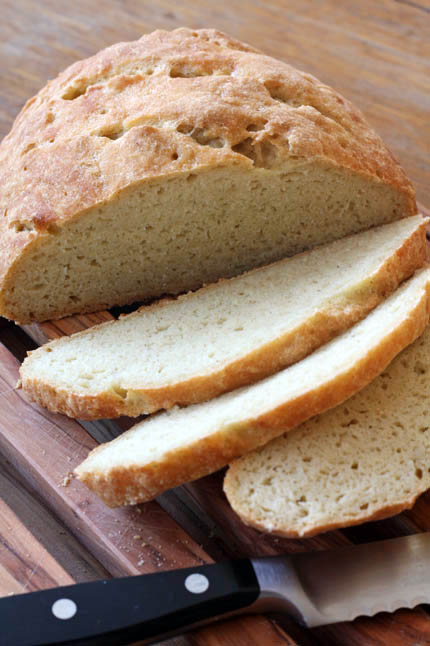
Gluten-free breads were a major request from readers of Artisan Bread in Five Minutes a Day. The options for buying gluten-free bread are both unsatisfying and expensive. So here is a wonderful bread that anyone, celiac or not, would want to eat.
Several readers have asked about the olive oil dough on page 302 of The New Healthy Bread in Five Minutes a Day. While the Crusty Boule (page 299 in the book) has a chewy and toothsome texture, the bread made with the olive oil dough has a much lighter, almost fluffy interior. Replace the neutral flavored oil in the Gluten-Free Crusty Boule recipe with olive oil if you prefer the texture of that loaf. They are both wonderful and give you fantastic options for free form loaves, sandwich breads, pizzas and even crackers. You will find all of these, plus many other gluten-free breads and awesome sticky buns in the book, with the link above.
For those of you who are celiac or just baking for someone who is you will find all of the directions and tips for handling gluten-free dough below. It is just as easy as the other recipes, but requires slightly different techniques and a new list of ingredients.
Gluten-Free Crusty Boule
Makes enough dough for at least four 1-pound loaves
2 cups Brown Rice Flour
1 1/2 cups Sorghum Flour
3 cups Tapioca Flour (also called tapioca starch)
2 tablespoons yeast (can be reduced but you will have to increase the rise time)
1 tablespoon kosher salt (increase or decrease to taste)
2 tablespoons Xanthan Gum
2 2/3 cups lukewarm water
4 large eggs, whisked together
1/3 cup neutral-flavored oil or olive oil
2 tablespoons honey or sugar
Click here to see the video of this recipe

Mixing and storing the dough: Whisk together the flours, yeast, salt and xanthan gum in a 5-quart lidded Round Food Storage Container. Combine the oil, honey and water, set aside.
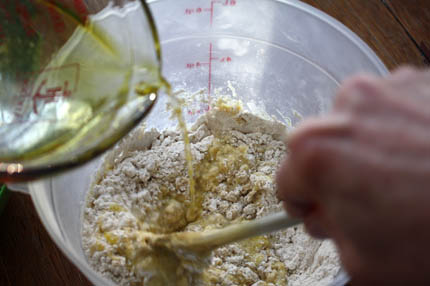
Dump the eggs into the dry ingredients and then stir while you pour in about 1/3 of the oil and water. Unlike my wheat doughs, do not add all of the liquid at once and stir. If you do, that will result in a lumpy dough.
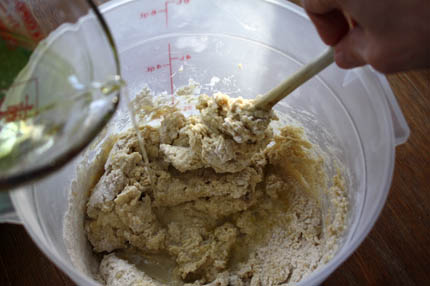
Continue to stir while you pour in another 1/3 of the liquid.
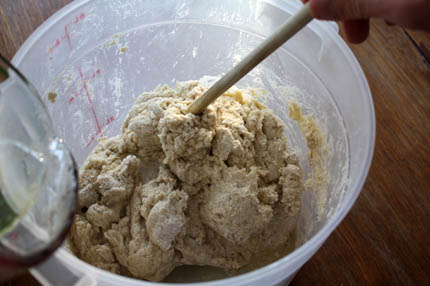
The dough will start to come together in a thick dough. Add the final 1/3 of liquid and
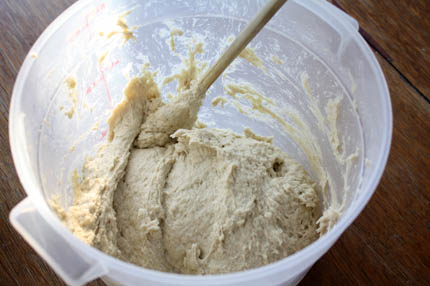
Stir until the dough is smooth. Cover with the lid, but do not snap it shut. Allow it to rest on the counter for about 2 hours. Place the dough in the refrigerator and store for up to 7 days. (I have a piece in the freezer and I will report back about how that turns out once I defrost it and bake it up. Stay tuned.)

On baking day take the bucket from the refrigerator. The dough will be quite fluffy still and you want to try not to handle the dough too much. Just like our other doughs the trick is to keep as much of the air bubbles in tact as possible.
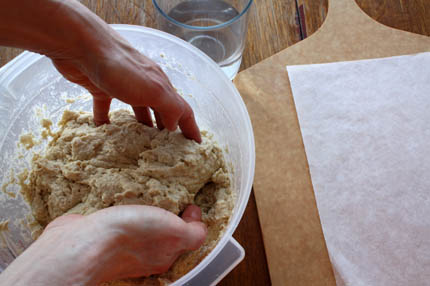
Use wet hands to remove 1-pound (grapefruit-size) piece of dough from the bucket.
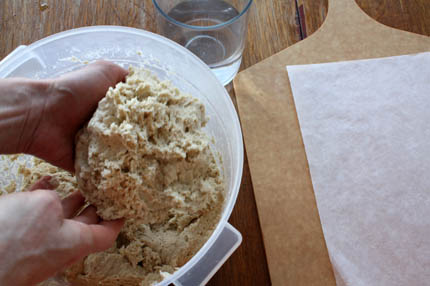
The dough will be quite scraggly when you take it out, just place it on a piece of parchment paper.
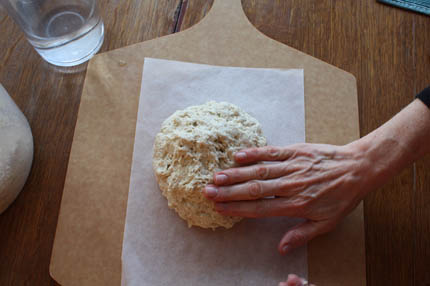
Use wet hands to smooth out the surface of the dough.
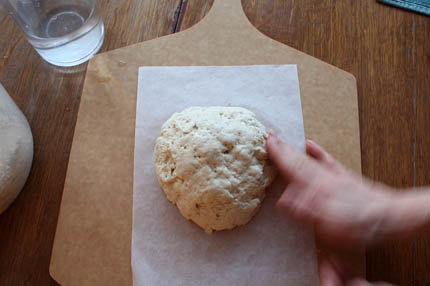
This may take dipping your hands in the water a few times…

to get a nice shape.
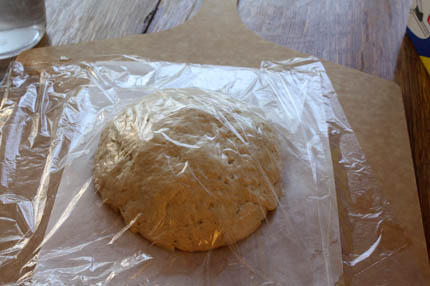
Cover loosely with plastic wrap and allow to rest on the counter for about 90 minutes. If your kitchen is very warm you may only need about 75 minutes.
30 minutes before baking time preheat the oven with a 5 1/2 quart Dutch Oven in it to 500 degrees. Be sure it is fitted with a metal Replacement Knob
, the original plastic knobs can only be heated to about 400 degrees. To find directions for baking on a stone see page 237 of HBin5.
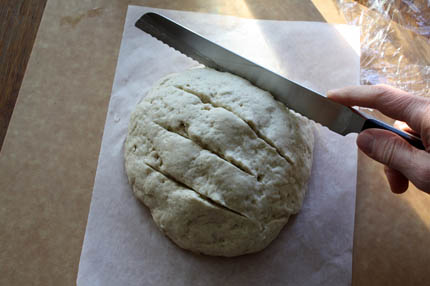
The dough will not have grown much while resting, but it will seem a little bit puffier. Use a serrated knife to cut slashes in the dough.
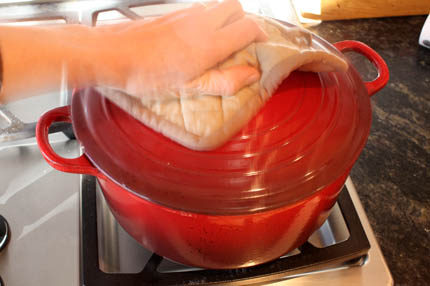
Remove the pot from the oven and take off the lid.

Lift the bread on the parchment and VERY CAREFULLY lower the parchment and bread into the pot, replace the lid onto the pot. Return to the oven and bake for 20 minutes. After the 20 minutes remove the lid, turn the heat down to 450 and bake for an additional 15 minutes.

Once the bread is done baking remove it from the pot using a spatula.
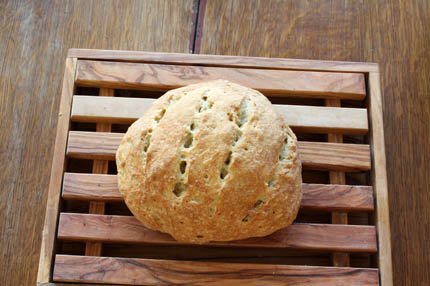
Allow the bread to cool completely before eating or the center may seem gummy.
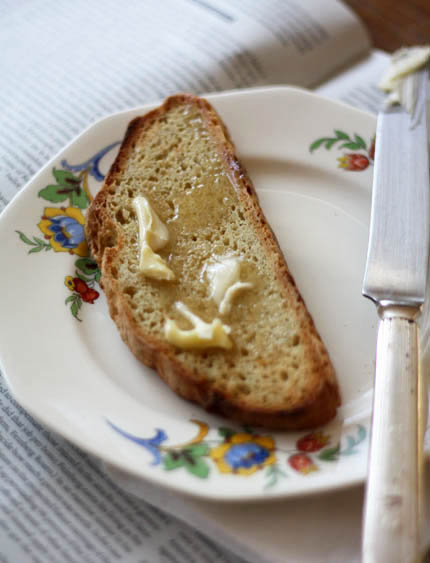
WEIGHTS for GLUTEN-FREE FLOURS
Brown Rice Flour: 1 cup = 5 1/2 oz = 155 grams
Tapioca Flour (Starch): 1 cup = 4 1/2 oz = 130 grams
Sorghum Flour: 1 cup = 4 3/4 oz = 135 grams
Cornstarch: 1 cup = 4 1/2 oz = 130 grams
Note: BreadIn5.com is reader supported. When you buy through links on the site, BreadIn5 LLC earns commissions.
The loaf looks perfect. I need to try a gluten free loaf!
Have made my first batch of the Master Recipe and am getting a really dense loaf that doesn’t really rise when baking. I’ve followed the directions to a “T” and even left the loaf rise overnight, still after 35 minutes baking, bread was doughy and very dense. What am I doing wrong?
Suzanne: You can’t let the loaf rise overnight, that leads to “over-proofing” where it collapses on itself. Stick with the recommended resting times (90 minutes for the whole grain loaves; assuming that’s what you’re baking, from our second book). Other suggestions about dense crumb: https://artisanbreadinfive.com/?p=141. And make sure you’re not using bleached flour, which doesn’t work in our recipes.
LJ: Sounds like a great variation! Jeff
I bought your new book and I love the gluten free bread recipes. These recipes have been going gluten free so much easier. I have tried 3 of the gluten free recipes from the book and all were great.
I’m SO thrilled to find this! I’m not gluten-free myself, but a dear friend is and this will be perfect. 🙂
Thank you for posting this! Just sent 3 gluten intolerant friends a link to your blog. they’ve been very jealous of my bread baking. 🙂
By the way, I’ve been playing with a hybrid of the whole wheat from book 2 and the basic recipe from book one, adding 1 TB vital wheat gluten for each of the 3 cups of WW flour I use. It makes a reasonably healthy bread that my kiddos will also eat.
The art of compromise!
Another printing error – I’m making the Whole-Grain Garlic Knots with Parsley and Olive Oil, and while there’s Parmesan in the ingredient list it never says what to do with it. I’m going to mix it in with the drizzle, so it’s like a lightly cooked pesto – I could also see sprinkling it over the knots after drizzling.
This is my first baking from the Master Recipe in HBin5. When I pulled the dough out of the bucket, there was basically no gluten development – didn’t need to cut the dough at all, it just tore right off. The first couple knots are very sticky and sloppy, too. I used a little more (white) flour in shaping the later ones and they look pretty good. I made the dough with KA Unbleached, KA White WW, and some very old vital gluten – I think I bought it within the last 5 years but I couldn’t swear to it. Does VWG ever go bad? It rose very nicely in the bucket before I refrigerated it, and then I didn’t use it for three days. I don’t know, it may come out fine. When I was rolling the ropes for the knots it was holding together nicely, even the overly sticky ones – never threatened to break up.
Hi jjmcgaffey,
Believe it or not it sounds like your dough may have been too dry, which is why you had little gluten development. With the use of KA flours and the vital wheat gluten your flour may have absorbed quite a bit of the water. Having said that the whole wheat doughs don’t have quite the same gluten development as the Master recipe made with all-purpose flour. Did you check our videos for HBin5 to see if your dough looked about the same.
Thank you for bringing the knots to our attention, we will get it added to the error page!
Thanks, Zoë
Jeff, thank you for your reply!! I’ve made a second loaf today and let it rise for 90 minutes, baked it, and just now took it out of the oven, after 40 minutes! I can tell it’s still doughy inside. I’m not a beginner to making bread so I know I’m doing everything as your recipe states (except for overnight rising!). My daughter in Iowa, who bakes bread more than I do, is having the same problem. I will try the refrigerator rising tomorrow and pray it works. Any more suggestions?! Thank you.
Hi Suzanne,
I’m assuming that you are referring the master recipe in HBin5? If your dough is too dry you will not get a good enough rise on the bread and it will come out dense. On the flip side if it is too wet your loaf will have too much moisture and come out too doughy. When you work with the dough does it keep a good shape to it? Have you had a chance to check out our videos about the bread? They may be helpful to see if your dough resembles what we are working with the in the video.
One issue that experienced bakers sometimes run into with our method is over handling the dough when you are shaping it into the loaf. It is crucial to our method not to over handle the dough or you will knock out all of the bubbles in the dough. These bubbles are what allow the dough to rise nicely.
If everything seems in order and you still are not getting the loaf you like you may consider adding more vital wheat gluten and a touch more water. This will give the dough more structure and allow it to rise better. Not too much or it will start to get tough.
You can also try the overnight refrigerator rise that you mentioned. Lots of things to try. Keep us posted!
Thanks, Zoë
And now I’ve baked the rolls – and they’re great! Lovely open crumb, crunchy crust, and no particular difference between the first sticky rolls and the later smoother ones. Gonna make pizza with the dough, now.
Link to a picture of the unstretchy dough, and the baked crumb: https://bluepegasuscc.com/gallery2/v/Baking/
Hi jjmcgaffey,
Now that I’ve seen the pictures of your dough I would say that it is a touch too dry, which is why you are not having the gluten development that you expect. Next time use a touch more water. This will require you to use more flour when shaping, but you will get a nicer dough.
Having said that if you are perfectly happy with how they came out you may not want to change a thing! Enjoy! Zoë
I’m one of the folks that requested the gluten-free recipes. 🙂 My son-in-law has celiac disease and I bought your new book for him and my daughter…as well as one for myself. They love the G-F recipes! They are both very busy people and having the bread dough ready in the fridge is a real time-saver. Now my SIL can have his gluten-free bread and my daughter can have her whole wheat. Thank you for listening!!
Patti
Hi Patti,
I am so thrilled that your family is using the g-f recipes.
Thank you so much for the suggestion and the lovely note!
Zoë
Wonderful flavor and texture. My only addition is to cool the loaf in the oven so that it stays as fluffy as possible and does not fall. Just turn off the oven, open the door and let the loaf cool more slowly.
Jeanie: That sounds like a great suggestion, must try that. Jeff
I love your recipes. My wife and I made the Apples and Honey Grain Challah. Ours spread out quite a bit. It’s delicious, but it really didn’t hold its shape. I noticed that it called for a 1/4 cup oil more than the Braided Challah. Would it be possible to decrease the oil in the Apples and Honey Grain Challah to help it keep its shape?
Bill: For any number of reasons, sounds like your dough is too wet. So yes, decreasing hte oil might very well help. Be sure you’re using unbleached, not bleached flour for the all-purpose (bleached doesn’t absorb enough water). Jeff
Thanks a lot for posting that recipe! I am not gluten intolerant and my bread baking involves sourdough which reduces the gluten intolerance risks BUT I love to bake differently and I think everyone’s health would benefit from a lower gluten overall diet.
And, as you already know it, I’m a huge fan of your wonderful work around bread baking! THANKS to both of you and, from my snowy countryside in France, all my best wishes for 2010 for your and your families 🙂
Thank you so much Flo,
Enjoy all the baking and bread! Stay warm.
Zoë
G*d BLESS You!!! I LOVED your original recipe, then I had to go GF and I’ve been truly missing good bread.
I can’t wait to try this. Thank you, thank you, thank you.
A thousand times THANK YOU!!!
Great job guys. I haven’t tried this master recipe but my GF wife is fired up about how good the brioche is.
Question: can egg replacement be used in place of egg? We’re allergic to egg as well as gluten…
Cynthia: We haven’t tested the various egg replacement products. One that I’ve been meaning to try is on Amazon at https://www.amazon.com/gp/product/B000EDI2C6?ie=UTF8&tag=arbrinfimiada-20&linkCode=as2&camp=1789&creative=9325&creativeASIN=B000EDI2C6“>Bob’s Red Mill Egg Replacer, 16-Ounce Packages (Pack of 4)<img src=”https://www.assoc-amazon.com/e/ir?t=arbrinfimiada-20&l=as2&o=1&a=B000EDI2C6″ width=”1″ height=”1″ border=”0″ alt=”” style=”border:none !important; margin:0px !important;
For those of us in-between (no wheat, but gluten is okay), can you also do some additional playing with replacing wheat flour with spelt, rye, teff, etc? I just got turned on to your system, and make a spelt-based boule and spelt/rye so far. They’re delicious, but don’t rise much, so they come out dense instead of airy.
Even flawed, this is a life-changer! I’m going to make the pizza rolls!
Stephanie: In Healthy Bread in Five, we have a variation with spelt in place of the whole wheat, and we’re happy with it. Be sure to use a whole grain spelt, not a “light” variety, or it will be too wet. And you must use Vital Wheat Gluten for it to turn out properly. Spelt itself has some gluten, so this isn’t for celiacs and others who don’t do well with gluten.
Without VWG, they really won’t rise much at all. Jeff
Yeah!! Amazon is now selling a great array of specialty flours in bulk, so get your baking friends together and order! Vital Wheat Gluten, Gluten free and specialty flours by Hodgson Mills, Bob’s Red Mill and others.
https://www.amazon.com/gp/search/ref=sr_nr_n_9?rh=n%3A16310101%2Cn%3A%2116310211%2Cn%3A16310221%2Cp_n_special_merchandising_browse-bin%3A492448011%2Cn%3A16317621&bbn=16310221&ie=UTF8&qid=1262875167&rnid=16310221
Thanks Jeff! Unfortunately that Bob’s egg replacer has wheat gluten in it. So it’s not an option for me. :o{
I’ll play around with it and see what happens. I just have to get one of those buckets.
Was so excited to find more GF bread recipes…especially since I enjoyed the first book so much before diagnosis. The bread is rising well and has nice crumb and texture but feels ‘wet’ after baking. In fact, lay it on the bread board and it leaves a wet impression of itself. Only deviation from the recipe is I baked it in a bread pan as my DIL had my cast iron pot. Could THAT have been the problem?
Nance: Doubt that’s the problem. Try using a little less water next time, or increase the baking time. Ingredients differ and that’s probably the issue. Jeff
No pre-heat oven, I saw posts on the The fresh Loaf about no pre-heating the oven before baking the bread. As we are trying to move to more green environment, I was wondering if I can do the same with the dough I make with ABin5 . Here are some links on the technique https://www.thefreshloaf.com/node/1843/no-knead-preheat [1]
https://www.thefreshloaf.com/node/3047/giving-no-preheat-try [2]
Hi Jane,
This is a very interesting concept and one that appeals to our interest in saving energy. I’m going to try it out and see what I think. I don’t think it will work with a baking stone, because the stone will take too long to heat up and prevent the bread from baking well.
Thanks, Zoë
Jane: I’m skeptical about how the crust will turn out, but I haven’t tested no-preheat myself, so I’ll reserve judgement. If you test our method with this approach, please post back to us on what you find. Jeff
Thank you for the response, but it sounds like I’m either out of luck or have to work on this on my own! I use spelt because I get ill from regular wheat. As such, VWG is not an option for me. I’ll try xanthan gum (couldn’t find it with the last batch I made, but just came across my bag), and see if it works.
Stephanie: That’s exactly what I was going to suggest, xanthan gum is in place of VWG. Use it the same way we do in our gluten free recipes, though you might be able to decrease it since spelt has some gluten in it. Jeff
My brother-in-law was in town for the holidays and he is Celiac. Looking through my new gift (HBin5), I spotted the gluten-free breads. Naturally I bought all the fixings and made him the boule (which he at most of before dinner) and then I had put together the gf brioche. With the brioche I rolled it and spread a cinnamon/sugar/butter mixture. Then rolled it back up, shapped it and plopped it in the brioche mold I also got as a gift. I sent that home with him because we made it the last day we were here. My wife says he is savoring 1 piece a day! Also took the brioche dough and made beignets with it. One of the things he missed most was doughnuts… I think he ate 10 🙂 Lastly we used the other half of the gf boule for a pizza crust. I used a little brown rice flour to help keep the dough from being too sticky for the pizza peel transfer, and it came out great. Had I not known it was gluten free, I never would have guessed. Anyways, it was a HUGE hit. Thanks so much for all the time and effort.
Kurt: So glad to hear stories like this, we were relatively new to gluten-free baking and were on pins and needles as to whether people would have success with them. It’s a great story about your BIL, our best wishes to him… Jeff
I can’t believe I missed this until today! Thank you so much for the nod. We were THRILLED to help. The bread looks gorgeous, and we’ve made it several times on our own, long after the testing for you was done.
For people who are just finding this recipe, enjoy!
Shauna: Your help meant so much to us, and the response from our readers has been terrific about these new breads (well, new to our world anyway!). Thank you again… Jeff
Hi Shauna,
Thanks to YOU and Danny for all of the advice and loving support as we figured out the art and science of g-f baking. The response has been so wonderful to this loaf!
xo Zoë
Wow, this looks SO good! Can’t wait to try it!
I’m so excited that y’all have written another breadbook that has GF RECIPES!!! WOO HOO!!! Thank you SO, SO much!!! I’m self-d’xed glutenfree, as of about 2 months, & have despaired of finding any good recipes for bread. I miss toast SO. MUCH. Maybe now I won’t have to! 🙂
My question is: Can I bake this in either an 8×4 or 9×5 loafpan? My hubby & I don’t have the $$ to buy one of those fancy Dutch oven dealies, but I REALLY want to try the bread!
Thanks so much!!
Bron
Bron: In the book, all our GF breads are done as free-form loaves, the website version uses the closed-pot method but it’s not by any means required, it just creates a really nice crust. I experimented for a while with loaf-pan breads as you suggest, and it works, but the center tends to be a little under-cooked– makes sure you’re done in the center. Given that, we opted for free-forms in the book, which tend to be smaller, for one thing, and all that nice surface area gives the heat a chance to drive off excess moisture. That doesn’t operate quite so well with a big loaf pan. Make small-ish ones, that’s one suggestion. Let us know what you find. Jeff
My 10 grain dough seems too dry. I’ll bake the first loaf but is there anything I can do to add liquid after 2 days in refrigerator?
Hi Pen,
If the bread seems to dry you can add a bit of water to the mix and just let it sit for a while so the flour can absorb it before forming and baking.
Enjoy, Zoë
I just have a comment to Stephanie. Spelt is an ancient type of wheat. So if you want to avoid wheat you should not eat spelt.
I have one question but first would like to thank you for creating the wonderful GF recipes. It’s changed my life!! Simple to make and tastes great. This is dangerous. 😉 Even my non-GF husband thinks the GF bread tastes great. He especially liked the pizza I made this weekend.
My question is: Is there supposed to be any “oven-spring” with the GF breads? My boules seem to be exactly the same size before and after baking.
Thanks, Carol
Hi Carol,
As you can see from my photos it grows a little bit, but not substantially. Do your loaves have a good texture or are they seeming a bit too dense?
Thanks! Zoë
My boyfriend’s sister bought me your first book before Christmas. This house has not been without fabulous fresh bread since.
I think I ‘ve blogged about your book 2-3 times already.
Can’t wait to try your newest book out.
Thanks so much!
Hi Frances,
Thank YOU so much, we are thrilled that you are enjoying the book and all the bread you bake!
Zoë
Hi – Can you offer any comment on using Pampered Chef (PC) stoneware for baking using your method? I was introduced to your bread method a few months ago, and have made oodles of loaves…we love it!
I am also an avid PC fan and have several of their stoneware, some in use for 10 or 15 years or more. About a month ago, the PC stoneware pan I was using cracked while baking bread. Although it was only 8 years old, I chalked it up to use and ordered a new one, which was pressed into service about 3 weeks ago. While baking bread last evening, the ‘new’ one cracked. Perhaps this new one was defective (and the previous one only had a partial life)? but it seemed a bit coincidental, and I am curious if you’ve received enough feedback from other bakers to be able to comment.
I definitely want to continue making artisan bread, but I of course also want to preserve my PC stoneware. Is there another type of stoneware that is better? What about baking artisan breads on metal (regular or airbake) pans?
Any feedback you can give would be appreciated-thanks so much!
Hi Anne,
The baking pan we recommend is a non-stick metal pan. Our dough is so wet that we fear it will stick to stoneware baking dishes? I have not heard from anyone else who has had this issue, but I bet we will now that you have posted. I’ll let you know if we get any feedback.
Be sure to use a lot of grease on your pan when baking so the dough won’t stick!
Thanks, Zoë
Anne M. I too am a PC fan also sold that great stuff. I’ve been using my PC pizza stone for ABin5 for months now with no problem. It’s well seasoned, as it seems yours was, having been used also formerly and currently for countless pizzas.
In fact it’s nearly black in color. The one I use for bread at our Maine house is also well seasoned. Electric here in FL and gas there in Maine. Go figure.
Zoe and Jeff, I was WONDERING what you guys would be up to next. Can’t wait to see the new book. Thanks again for the first two and for being so responsive here to your loyal fans. You have changed our lives!
Hi Margot,
I just knew our readers would come to Anne M’s rescue. Thanks. Do you have any experience with the stoneware loaf pans from PC?
Glad you are enjoying all the bread! Zoë
Hello! I got my copy of HBin5 for Christmas and proceeded to undertake whole grain garlic knots with parsely and olive oil. I came across one error in the recipe – 2 T. of Parmesan are listed in the ingredients, but what to do with it is nowhere in the directions. I guessed and sprinkled it on the top before baking. My husband and I thought that tasted alright, but I would like to know your plans for it. Thanks!
Thanks Kelly, others have mentioned as well… Jeff
My 19 yo daughter is home on her college break. She has celiac so we are trying this bread today. I have the book, but looked up this site to find the dutch oven instructions..
I would like to know where you got that beautiful cooling rack. Is it availabe somewhere online?
Heather: Well, it belongs to Zoe, but here’s something similar on Amazon: https://www.amazon.com/gp/product/B00029HBOW?ie=UTF8&tag=arbrinfimiada-20&linkCode=as2&camp=1789&creative=9325&creativeASIN=B00029HBOW“>Mountain Woods Multi-Purpose Cutting Board and Crumb Tray
Hi Zoe,
My loaves have a great texture and do not seem dense at all. The sliced bread looks just like the one in the photo. So no complaints. Just was wondering about the oven spring. I tried a 1.5 lb piece of dough in a loaf pan and ended up with an oval boule, not a sandwich loaf. It never expanded to touch the sides of the loaf pan. No rising (to the naked eye, anyway). It turned out wonderful, too.
Carol
Carol: We’re finding that for most loaf pans you buy, they take closer to 2 lbs of dough to really fill the thing and reach the sides, and get tall. Oven spring is relatively modest for GF breads… Jeff
I’ve been using the PC stoneware for the breads for over a year now with spectacular success. I have used the rectangle baking stone, 9×13 pan with cover, deep dish baker with cover and mini deep dish baker with cover. The covered stoneware is a great alternative to the covered casserole dishes. The 9×13 accommodates a baguette or ciabatta loaf nicely. I also use it for rolls. The deep dish baker is great for a 1 1/2 lb boule and the mini deep dish baker is great for a 1lb boule.
Hope that helps!
Cathie: I’ve had very good success with stoneware covered vessels for baking, check out my post on this at https://artisanbreadinfive.com/?p=566. Different brand but I think they all work about the same. Jeff
thanks to Jeff and to Mie. I am able to eat spelt, for whatever reason, without ill effect. It seems it’s not uncommon to be able to eat spelt, but be intolerant to regular wheat, farro and semolina/durham. (this is not true for celiacs, of course!)
I’ll try the xanthan gum on my next batch. The one currently “cooking” in the fridge will probably be pizza rolls! My children devoured the rye like crazy, rise or not.
This is not a comment on a gluten free recipe ( haven’t tried them yet) but about my new favorite A/HBin5 loaf! I want to thank Betsy, wherever you are – Betsy’s Seeded Oat Bread p.147 in HBin5 is the the best bread I have baked from both books. It was wonderful last night with homemade chicken soup and heavenly this morning as toast. For whatever reason, the loaf spread a bit (side-ways oven rise/spread?) but that just gave me more of that crunchy mouthwatering crust! I topped mine with poppyseeds (due to an Amazon ordering error I now have 4 lbs of poppy seeds!) – likely many upcoming breads will be poppyseeded. I am about to bake a quinoa loaf today and will report my results. (since the oven and the stone is hot, I think a second Betsy’s loaf is in order, too. FYI-I have been using the upside down aluminum pan for my “cloche” and it is very easy and seems to work quite well crust-wise.
Amy: Yeah, Betsy was a winner, yes. She was a real help to us. Thanks Betsy, if you’re reading this. Jeff
I love you guys. No, seriously.
I just baked my first loaf today after mixing the dough yesterday. I thought the dough and boule was WAY too wet, but I just trusted you. After baking it has amazing texture and crust. It’s not gummy at all and actually has TASTE, not like the cardboard crap you can get in the frozen food section at the store.
I can’t thank you enough. Love is what I’m feeling now. Seriously.
Anna: You’re very, very sweet. Thanks so much…
Jeff
Yes, Zoe, I’ve used my Pampered Chef loaf pan with ABin5 recipes. It was seasoned when I started using it with your recipes and I was able to bake without spraying or greasing the pan. My loaves pop right out, with no sticking.
Hi Margot,
That is fabulous to hear, sounds like a great product!
Thanks, Zoë
Thank you SO MUCH for sharing this recipe! not only am i exited at the prospect of baking bread again, but oh my goodness, this is the most amazing bread I’m ever tasted — not just in the 3 1/2 past years without any bread.
I now can’t wait to get the new book in and find the other gluten-free goodies you have hiding in there. And I’m sharing this post with everyone I know right now! Thank you, thank you, thank you!
(and thank you Shauna for sharing the link on Twitter to this!)
Hi Kelly,
Thank you, your note was wonderful to hear. We are so thrilled that you are enjoying it so much!
Cheers, Zoë
Quinoa loaf is wonderful – highly recommended!
Thank you Amy! 🙂 Zoë
HOT CROSS BUNS – can you come up with a recipe – PLEASE
Hi Jill,
Are you looking for a g-f recipe for hot cross buns? If not, here is a recipe we did https://artisanbreadinfive.com/?p=571.
Thanks, Zoë
I have a gluten intolerant friend and stumbled upon this recipe. I went out and bought the book this past weekend and made the Olive Oil Gluten free bread. OH MY GOSH!! I was totally amazed at the taste and the texture. I did bake it in the pot with the parchment and I think that really made the difference. Thank you so much for a wonderful recipe. Can’t wait to try more of the recipes.
Hi Barb,
I’m so thrilled! Did you use the Olive Oil dough from the book or the Crusty Boule and substitute olive oil?
Thank you so much for trying the recipe! Zoë
Jeff and Zoe – so after baking your wonderful breads for a year, I now have to go gluten-free for a while to see if gluten is an issue for me. I despaired for I love the ABin5 loaves, but your gluten-free chapter in HBin5 looks promising. Thank you for putting this chapter in!
I wasn’t able to find all the flours for the gluten-free loaf in my local store, but I was able to get teff flour. I’ve just tasted my first gluten-free loaf (the not rye), and it’s pretty good. The taste is quite good, but the loaf is pretty dense and a bit crumbly. Suggestions for improvement? I also was able to buy quinoa flour, but haven’t yet figured out the different gluten-free flours and which can replace each other. Any suggestions you have from your experiments would be appreciated!
Hi Linda,
The gluten-free flours not only have incredibly different flavors, but they also behave very differently in the recipes. I’m not sure from your note if you were able to find all the flours you need for the mock rye or just the teff. If you made substitutions you may want to give it a try again once you find the other flours. It is less convenient, but I believe you can find them online?
Thanks, Zoë
How would I go about making dinner rolls using the GF Boule recipe? Is it as easy as I’m thinking–pull out small pieces from the master loaf and let them rise and cook similarly to a full loaf?
Hi Beth,
That is exactly what I would do. Depending on how small, you may only have to let the rest for half the time listed.
Thanks and let me know how that goes! Zoë
I’ll definitely let you know how it goes, Zoe!
I had another question–would you suggest storing the GF breads the same as their gluten counterparts? Or do they need to be stored differently due to them being GF?
Beth: Storage is always the same for us– we always prefer to bake small loaves and replace often with fresh ones. But… if you want to store it, same instructions as for non-GF. The best way for same-day storage is cut-side down on a non-porous surface like a plate, synthetic cutting board, or clean countertop. This preserves the character of the crust, at least a little. If you’re storing for tomorrow they seem to do better in foil or plastic, but that really softens the crust. Jeff
Now that I’ve made my first loaf, I cannot imagine the bread will stay around long enough for storage to be an issue. The GF Boule is absolutely wonderful!!! I had become very discouraged with the recipes and mixes I’ve tried for GF breads. But this one–it’s a keeper! After the first bite I knew because I immediately wanted a second bite. The sandwich I had for lunch was the first sandwich in two years that I’ve gotten excited about. Sad that it had to be that way, but great for those of us who’ve found our way to your book!
Next up is using the dough for pizza crust this weekend. And once I use up the Boule master recipe, I’ll be trying the Mock Rye. I miss rye so much!
Thank you, Jeff and Zoe!
Hi Beth,
Thank you, it is a thrill to read your note. I am so pleased that you are excited about your sandwiches again! 🙂
You are going to love the rye!
Zoë
I am so very excited about this! I’d been pining over pictures friends have taken of bread they’ve made from the book, and I had no idea there was a GF chapter. Thanks for publishing this recipe, I’m not sure I’ll buy the whole book just for one chapter (my kitchen is completely gluten free, so I’ll never use the rest of the book), but this is something I can use… and will tomorrow! Thank you thank you thank you! 😀
Hi Kate,
Enjoy the bread! There are sweet doughs, pizza and a variety of other gluten-free breads in the book. Mostly wheat, but that chapter stands alone. Perhaps check it out from the library and see what you think!
Thanks, Zoë
Have successfully baked the whole grain master recipe then tried the 10-grain bread and was disappointed. The 10-grain was very heavy, and rose very little. Any suggestions?
Hi Rosann,
It sounds like your dough could be too dry. Just try adding a few tablespoons to the remaining dough and see if that helps the rise. After you add the water let it sit for a while so the flour can absorb it.
Let us know if that does the trick.
Zoë
Can I make this without yeast? How?
Thanks
Hi Jon,
I have not yet tried using a natural sour starter with this recipe. you would need to add about a cup of your starter and replace some of the water and flours to account for it. Here is a post about using starters for the wheat breads, which may give you some help as you experiment. https://artisanbreadinfive.com/?p=1284
Thanks and let me know how it goes if you try it.
Zoë